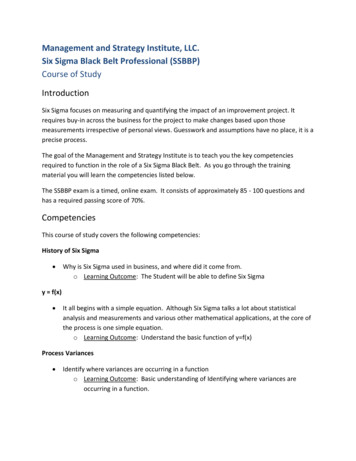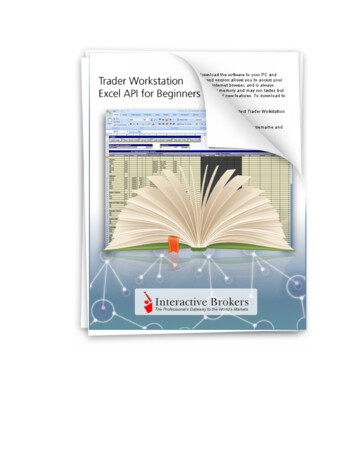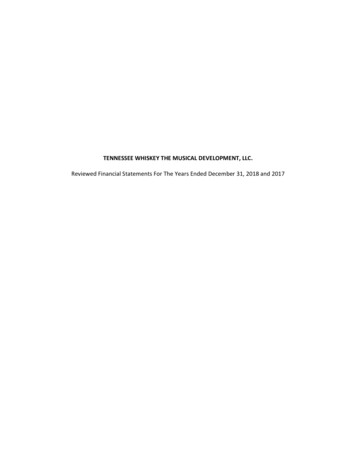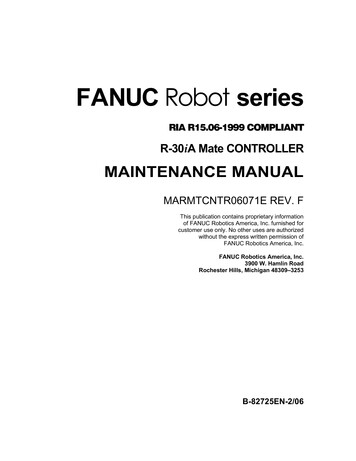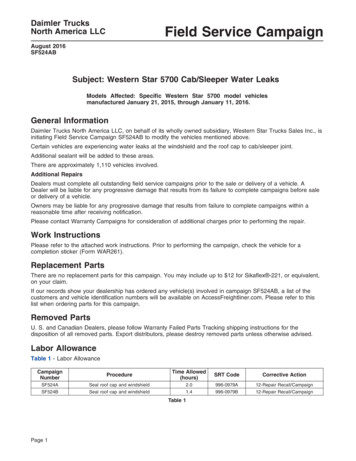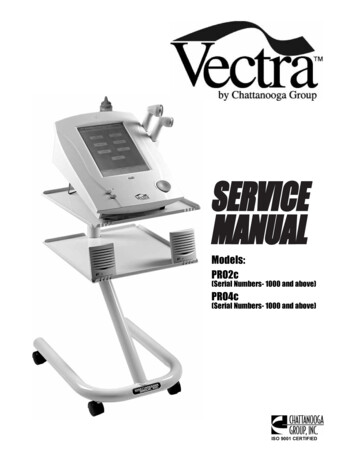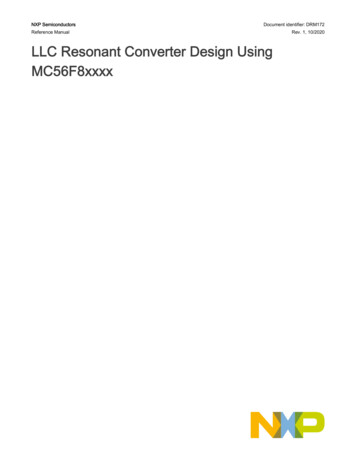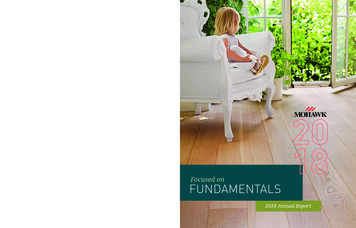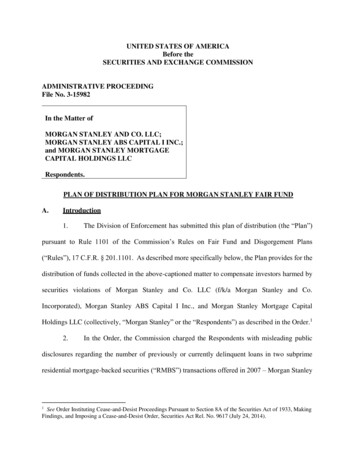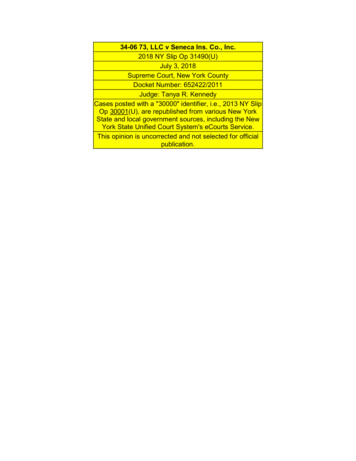
Transcription
34-06 73, LLC v Seneca Ins. Co., Inc.2018 NY Slip Op 31490(U)July 3, 2018Supreme Court, New York CountyDocket Number: 652422/2011Judge: Tanya R. KennedyCases posted with a "30000" identifier, i.e., 2013 NY SlipOp 30001(U), are republished from various New YorkState and local government sources, including the NewYork State Unified Court System's eCourts Service.This opinion is uncorrected and not selected for officialpublication.
[* 1]INDEX NO. 652422/2011NYSCEF DOC. NO. 273RECEIVED NYSCEF: 07/05/2018SUPREME COURT OF THE STATE OF NEW YORKCOUNTY OF NEW YORK: IAS PART ------)(34-06 73, LLC, BUD MEDIA, LLC andCOORS MEDIA, LLC,Index No. 652422/2011Plaintiffs,- againstDECISION AND ORDERSENECA INSURANCE COMPANY, -------------------- )(TANYA R. KENNEDY, J.S.C.:Motion sequences No. 009 and 010 are consolidated for disposition.This action arises from a fire that occurred on September 8, 2009 in a vacant commercialwarehouse at 50-09 27th Street, Long Island City, New York (the Premises).Defendant Seneca Insurance Company, Inc. (Seneca) issued an insurance policy, numberFTZ 1000661 (the Policy) to plaintiffs covering various properties, including the Premises, forthe period of April 1, 2009 through April 1, 2010. Non-party Mohammad Malik (Malik) ownsthe Premises.In motion sequence no. 009, plaintiffs move to dismiss Seneca's fourth affirmativedefense, which asserts noncompliance with the Protective Safeguards Endorsement (theEndorsement) for failing to maintain an "Automatic Sprinkler System" at the time of the fire asrequired by the Policy. In motion sequence No. 010, Seneca moves for summary judgment,dismissing the complaint, based upon Seneca's fourth affirmative defense.Seneca retained a company to perform loss control inspections of Malik's variousproperties, including the Premises, for underwriting purposes (Muller Affidavit, Ex. A). The12 of 11
[* 2]INDEX NO. 652422/2011NYSCEF DOC. NO. 273RECEIVED NYSCEF: 07/05/2018Report, dated April 27, 2009, (the Report) set forth four (4) recommendations pertaining to thePremises (Lynn Affirmation, Ex. A).In an April 30, 2009 letter to Malik, Seneca, advised Malik, in part, that:"[t]he attached recommendations result from our recent inspectionof the captioned location for underwriting purposes. Please contactyour agent/broker or the Company and advise us of your action onthese recommendations in the next 30 days. FAILURE TOCOMPLY WITH THESE RECOMMENDATIONSBY:- -MAY RESULT IN THE CANCELLATION OF YOURPOLICY"(id., Ex. B [capitalization in original]).The deadline for compliance in the above referenced letter was left blank. Therecommendations for the Premises were as follows:2009-001 : The insured must restore the sidewalks to a flat and even condition.2009-002: The insured must provide full interior access if necessary.2009-003: The insured must contact the broker if the building is occupied.2009-004: Make the insurer aware that the sprinkler system is currently out ofservice.(id., Ex. B).Seneca followed up on some of the recommendations regarding Malik's variousproperties, as evidenced by emails (Muller Affidavit, Exs. C, D, E). However, none of theemails provide any status as to Malik's compliance with the sprinkler system recommendationfor the Premises. It is undisputed that Seneca did not cancel the Policy once it became awarethat the sprinkler system was out of service.Seneca forwarded an April 13, 2011 letter to Malik denying plaintiffs' claim resultingfrom the fire due to plaintiffs' breach of the Endorsement and breach of the "concealment,misrepresentation or fraud" provision of the Policy (Lynn Affirmation, Ex. C). Plaintiffs thencommenced this action for breach of contract.23 of 11
[* 3]INDEX NO. 652422/2011NYSCEF DOC. NO. 273RECEIVED NYSCEF: 07/05/2018Plaintiffs served a Notice to Admit (id., Ex. F) and Seneca admitted that it knew theReport indicated that the fire sprinkler system at the Premises was out of service (id., Ex. G).Seneca also admitted that it did not cancel the Policy on such ground (id.). Further, Senecaadmitted that it "did not cancel the policy within the time period that it had the legal right tocancel a new policy for non-compliance with recommendations, but continued to communicatewith plaintiffs' representatives with respect to the recommendations concerning the propertiescovered by the subject policy" (id.). As such, Plaintiffs argue in support of the motion to dismissthat Seneca had the right, pursuant to the terms of the Policy and Insurance Law §3426 to cancelthe Policy within the first sixty (60) days and waived its right to enforce the Endorsement.Seneca argues in opposition that it did not knowingly, voluntarily and intentionallyabandon its right to rely on the Endorsement. The deposition testimony of Carol Muller(Muller), a Seneca vice-president in the underwriting department, indicates that Seneca did notcancel the Policy because "[i]t was a nice-size premium. We thought the [recommendations]would get complied with . this was a good producer [and] we had a Protective SafeguardEndorsement on the Policy" (id., Ex. H at 101; see Muller Affidavit, 6, Ex. B at 113 ).Muller also indicated in her deposition testimony that "we normally try to get the[recommendations] complied with. We don't want to lose a 41,000.00 account" (LynnAffirmation, Ex. H at 102). Although Muller maintained that Seneca followed up on therecommendations, she acknowledged that there were no written communications regarding theEndorsement (Muller Affidavit, 8).Seneca argues in support of its motion for summary judgment that plaintiffs breached theEndorsement by failing to maintain an Automatic Sprinkler System at the time of the fire.Among the exhibits annexed to the motion are the deposition transcript of John A. Gleason, a34 of 11
[* 4]INDEX NO. 652422/2011NYSCEF DOC. NO. 273RECEIVED NYSCEF: 07/05/2018retired Battalion Chief with the New York City Fire Department (Exhibit D) and a photograph ofthe control valves of the sprinkler system in the Premises taken by a New York City FireMarshal at the fire scene (Deposition Ex. 4).Chief Gleason testified that he oversaw the firefighting operations at the premises andwas required to prepare an incident report (p. l 0). The report he prepared indicated that due tothe magnitude of the fire and the lack of a sprinkler alarm, no automatic sprinkler system waspresent (pp. 23-24).According to Chief Gleason, the New York City Fire Marshal photograph of the controlvalves of the sprinkler system in the Premises at the fire scene which depicts the valves asunchained and closed (Deposition, Ex. 4), was supposed to be chained in the open position(pp.25-30). Chief Gleason also maintained that the sprinkler system would not operate ifthecontrol valves were in the off or closed position (pp.27-30).Plaintiffs argue in opposition that issues of fact exist which preclude the grant ofsummary judgment. Among the exhibits annexed to the opposition papers are the examinationunder oath (EUO) transcript of Malik (Ex. D); the EUO transcript ofEzaj Shaheen (Shaheen),the maintenance manager of the Premises (Ex. F); deposition transcripts and affidavit ofKhiongLau (Lau), a former Chief Fire Contractors, Inc. (Chief Fire) employee (Exs. J, K, L) and thedeposition transcript of Frank Rivera (Rivera), a Chief Fire Supervisor (Ex. M).Malik testified that he entered into a contract with Chief Fire in September 2008 toconduct monthly maintenance and inspections on the sprinkler system from October 2008through September 2009 (pp. 65-66). He also maintained that Chief Fire installed bells on thesprinkler system (pp. 48-49). According to Malik, the sprinkler system was working when hepurchased the building and at the time of the fire (pp. 43; 164).45 of 11
[* 5]INDEX NO. 652422/2011NYSCEF DOC. NO. 273RECEIVED NYSCEF: 07/05/2018Shaheen testified at his EUO that he visited the premises on May 1, 2009, after hereceived a call the night before from Malik regarding a leak; that he conducted the necessaryrepair on May 1, 2009; and tested the system after his repair (pp. 43-46). He also testified thatChief Fire inspected the sprinkler system every month from October 2008 through October 2009(p.24) and that Chief Fire recorded each inspection on an inspection certificate located on a wallnext to the sprinkler system (pp. 31-32).Lau testified that he was the person responsible for conducting monthly visualinspections of the sprinkler system at the Premises (p. 14). Lau indicated that his February 2009inspection of the sprinkler system revealed the system was down, which he reported to ChiefFire's owner (pp. 18; 61-63). ·Lau also testified that he never returned to the Premises after hisFebruary 2009 inspection and that he did not know which Chief Fire employee returned to thePremises to inspect the sprinkler system after the date of his inspection up until the time of thefire (pp 74-75).However, Lau submitted an affidavit a month before his deposition testimony, when hewas a Chief Fire employee, indicating that he personally conducted visual inspections of thesprinkler system from October 2008 through September 2009 and that he filled out the inspectioncard which he always maintained at the Premises to document hisactivity( 9-11). Lau furthermaintained in his affidavit that Chief Fire did not maintain a copy of the inspection card and thatat the request of Chief Fire's owner, he reproduced the inspection card based upon Chief Fire'sfiles and his memory after the card was destroyed in the fire( 13-15).Rivera testified that he supervised the Chief Fire inspectors (pp. 9-10) and that it was notuncommon in his experience for a sprinkler system to operate when the alarm bell did not ring(p. 25).56 of 11
[* 6]INDEX NO. 652422/2011NYSCEF DOC. NO. 273RECEIVED NYSCEF: 07/05/2018MOTION TO DISMISS FOURTH AFFIRMATIVE DEFENSECPLR 321 l(b) provides that "[a] party may move for judgment dismissing one or moredefenses, on the ground that a defense is not stated or has no merit." As such, plaintiffs bear theburden of demonstrating that the fourth affirmative defense is without merit as a matter of law(see Vita v New York Waste Servs., LLC, 34 AD3d 559, 559 [2d Dept 2006]).Insurance Law §3426 states:(b) During the first sixty days a covered policy is initially in effect, except for thebases for cancellation set forth in paragraph one, two or three of subsection (c) ofthis section, no cancellation shall become effective until twenty days after writtennotice is mailed or delivered to the first-named insured at the mailing addressshown in the policy and to such insured's authorized agent or broker.(c) After a covered policy has been in effect for sixty days unless cancelledpursuant to subsection (b) of this section, or on or after the effective date if suchpolicy is a renewal, no notice of cancellation shall become effective until fifteendays after written notice is mailed or delivered to the first-named insured and tosuch insured's authorized agent or broker, and such cancellation is based on oneor more of the following:(1)With respect to covered policies:(D) after issuance of the policy or after the last renewal date, discovery of an actor omission, or a violation of any policy condition, that substantially andmaterially increase the hazard insured against, and which occurred subsequent toinception of the current policy period;A party may waive its contractual rights "if they are knowingly, voluntarily andintentionally abandoned," which is "established by affirmative conduct or by failure to act so asto evince an intent not to claim a purported advantage" (Fundamental Portfolio Advisors, Inc. vTocqueville Asset Mgt., L.P., 7 NY 3d 96, 104 [2006] [internal quotation marks and citationsomitted]). Further, waiver "should not be lightly presumed and must be based upon a clear67 of 11
[* 7]INDEX NO. 652422/2011NYSCEF DOC. NO. 273RECEIVED NYSCEF: 07/05/2018manifestation of intent to relinquish a contractual protection" (id at 104 [internal citationsomitted]).The fact that "a party's reluctance to terminate a contract upon a breach and its attemptsto encourage the breaching party to adhere to its obligations under the contract do not necessarilyconstitute a waiver of the innocent party's rights in the future" (Kamco Supply Corp. v On theRight Track, LLC., 149 AD3d 275, 281 [2d Dept 2017] [internal quotation marks and citationsomitted]).Here, the evidence shows that Seneca knew that the Report indicated that the sprinklersystem was not in service. Seneca also admitted that it did not terminate the Policy due toeconomic reasons; its reliance on the Endorsement; and belief that plaintiffs would comply withthe recommendations. Although Seneca followed up on the recommendations, Mulleracknowledged there were no written communications regarding the Endorsement. As such,factual issue exists which prevent plaintiffs from demonstrating that Seneca knowingly,voluntarily and intentionally abandoned its right to enforce the Endorsement. Therefore, themotion to dismiss is denied.MOTION FOR SUMMARY JUDGMENTThe proponent of a summary judgment motion must establish its prima facie entitlementto judgment as a matter of law, tendering sufficient evidence to demonstrate the absence of anymaterial issues of fact (see Alvarez v Prospect Hosp., 68 NY2d 320, 324 [1986]). Once thisshowing has been made, the burden shifts to the party opposing the motion for summaryjudgment to produce evidentiary proof, in admissible form, sufficient to establish the existenceof material issues of fact which require a trial of the action (see Zuckerman v City of New York,49 NY2d 557, 562 [1980]).78 of 11
[* 8]INDEX NO. 652422/2011NYSCEF DOC. NO. 273RECEIVED NYSCEF: 07/05/2018A warranty is "a promise by the insured to do or not to do something that the insurerconsiders significant to its risk of liability under an insurance contract" (Triple Diamond Cafe,Inc. v Those Underwriters at Lloyds of London, 124 AD3d 763, 765 [2d Dept 2015]). Further, aprotective safeguard provision qualifies as a warranty as defined by Insurance Law § 3106 (seeAnghel v Utica Mut. Ins. Co., 127 AD3d 897, 899 [2d Dept 2015]).New York Insurance Law § 3106 provides:(a)In this section "warranty" means any provision of an insurance contract which hasthe effect of requiring, as a condition precedent of the taking effect of suchcontract or as a condition precedent of the insurer's liability thereunder, theexistence of a fact which tends to diminish, or the non-existence of a fact whichtends to increase, the risk of the occurrence of any loss, damage or injury withinthe coverage of the contract. The term "occurrence of loss, damage or injury"includes the occurrence of death, disability, injury, or any other contingencyinsured against, and the term "risk" includes both physical and moral hazards.(b)A breach of warranty shall not avoid an insurance contract or defeat recoverythereunder unless such breach materially increases the risk of loss, damage orinjury within the coverage of the contract. If the insurance contract specified twoor more distinct kinds of loss, damage or injury which are within its coverage, abreach of warranty shall not avoid such contract or defeat recovery thereunderwith respect to any kind or kinds of loss, damage or injury other than the kind orkinds to which such warranty relates and the risk of which is materially increasedby the breach of such warranty.Insurance Law § 3106 precludes coverage as a matter of law where the insurer establishesa breach of warranty which materially increases the insurer's risk ofloss within the coverage ofthe policy (see Star City Sportswear v Yasada Fire & Mar. Ins. Co. ofAm., 1AD3d 58 [1st Dept2003], affd 2 NY 3d 789 [2004]; Triple Diamond Cafe, Inc. v Those Certain Underwriters atLloyd's London, supra).Seneca cites to Triple Diamond Cafe, Inc. v Those Certain Underwriters at Lloyd'sLondon, supra, in support of its argument that plaintiffs failed to comply with the Endorsementby failing to maintain an Automatic Sprinkler System at the Premises, which voids insurance89 of 11
[* 9]INDEX NO. 652422/2011NYSCEF DOC. NO. 273RECEIVED NYSCEF: 07/05/2018coverage as a matter oflaw. In Triple Diamond Cafe, supra at 765, the "special conditions"section of the declaration page stated "[w]arranted . burglar alarm[s] will be [f]ully operationalthroughout the period of the policy." The property in Triple Cafe was consumed by fire anddefendant insurer denied coverage after defendant's investigation conduded that the alarmsystem was not activated at the time of loss.The Appellate Division, Second Department in Triple Diamond Cafe, supra, affirmed themotion's court grant of summary judgment and determination that plaintiff was not entitled tocoverage under the policy as a matter oflaw since the plaintiff breached the warranty, whichmaterially increased the risk of loss.Unlike Triple Diamond Cafe, supra, there are conflicting versions as to whether thesprinkler system was functional at the time of the fire. The deposition and EUO transcripts, aswell as affidavits raises issues of credibility, which cannot be determined on a motion forsummary judgment (see S.J Capelin Assoc. v Globe Mfg. Corp., 34 NY2d 338, 341 [1974];Santos v Temco Serv. Indus., 295 AD2d 218, 218-219 [1st Dept 2002]). Further, the fact thatthis Court determined that an issue of fact exists as to whether Seneca knowingly, voluntarilyand intentionally abandoned its right to enforce the Endorsement also precludes the grant ofsummary judgment.Accordingly, it isORDERED that plaintiffs' motion (motion sequence No. 009) to dismiss the fourthaffirmative defense is denied; and it is further910 of 11
[* 10]INDEX NO. 652422/2011NYSCEF DOC. NO. 273RECEIVED NYSCEF: 07/05/2018ORDERED that defendant's motion for summary judgment dismissing the complaint isdenied; and it is furtherORDERED that the parties are directed to attend a status conference at 60 Centre Street,Room 321, on September 5, 2018 at 2:15 p.m.This constitutes the decision and order of the Court.Dated: July 3, 2018ENTER:rl clrTANYA R. KENNEDY rm r & ae.-.;.; ·1011 of 11J.S.C.
Defendant Seneca Insurance Company, Inc. (Seneca) issued an insurance policy, number FTZ 1000661 (the Policy) to plaintiffs covering various properties, including the Premises, for the period of April 1, 2009 through April 1, 2010. Non-party Mohammad Malik (Malik) owns the Premises.
